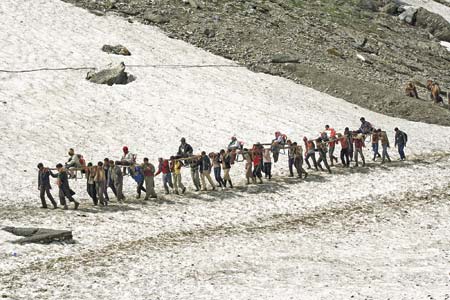The unrestricted flow of yatris towards the holy Amarnath cave could impact the environment which will have serious ramifications on the major economic sectors in Jammu and Kashmir. This, experts believe, can snowball into a larger crisis in future, Syed Asma reports.
While the Supreme Court has kept silent over restricting the number of pilgrims visiting the holy Amarnath cave, the environmentalists are of the opinion that human intervention plays a part in changing the environment. Talking about the yatra’s consequences on the environment, Shakil A Ramshoo, a glaciologist, who has studied the glaciers in Jammu and Kashmir says that the huge number of humans visiting the holy cave contributes to the melting of glaciers in and around the track leading to the cave.

A study sponsored by the centre which was done by the department of geology at University of Kashmir reveals that Kolahai, one of the largest glaciers of Kashmir Himalayas, has been melting at a fast rate. The glacier has developed several cracks over the years and there has been 18 percent shrinkage in the glacier size over the last 30 years, the study shows. “The glacier area has shrunk from 13.87 sq km in 1976 to 11.24 sq km in 2006,” Ramshoo says.
“Though, we have a huge rush of tourists each year, but they don’t have an access to higher altitude sites like these. It is mostly yatris, gujjars and Indian troops who contribute to the damage more effectively and more directly,” says an environmentalist who wished not to be named.
With the glaciers depleting fast, Ramshoo believes it might lead to scarcity of water in Kashmir in coming decades which can have larger repercussions on some major sectors like agriculture, horticulture and hydropower generation capacity in the state. “The depleting glaciers can even worsen the relationship between India and Pakistan as water is the actual reason of the conflict between the two countries.”
Another study on glacier depletion in Kashmir done by Muneer Ahmad, an environmental expert at National Geophysical Research Institute, Hyderabad, says the Kolahai Glacier has been shrinking since the start of 19th century but in the last decade it has been receding quite fast.
An independent study shows says that Najwan Akal, a major glacier in the upper reaches of Sindh in Ganderbal has completely disappeared. Besides, Thajwas, Zojila and Naranag glacier have also been considerably reduced. “The quantity of snowfall has clearly reduced over the last decades. Cement plants in the Kashmir valley are producing heat-trapping gases that could lead to no snow in the plains in the next two decades,” the study says, “More than 300 military convoys producing high-level green house gases move across the valley every day. The gases emitted by these vehicles disturb the atmosphere of the valley. The annual Amaranth Yatra is proving disastrous to the fragile environment of the area,” Ahmed’s study says.

Apart from the concern of melting of glaciers in Kashmir at a considerable rate, other issue raised by the environment experts is pollution caused by the movement of yatris to the two major rivers, Lidder and Sindh, along the tracks of Amarnath cave. These rivers, apart from providing support to a significant quantity of aquatic lives, are a source of drinking water to some parts of Kashmir as well. Medical authorities in Kashmir sounded an alert after the yatra ended on Aug 2 when an unusual number of Diarrhea cases were reported in Ganderbal district, one of the base camps of Amarnath Yatra. At least 15 people were infected after the outbreak of Diarrhoea in many villages of Kangan including Rayil, Kullan, Gund, Haknar and Fraw.
A research paper of Irfan Rashid and Shakil A Ramshoo about the ‘impact of anthropogenic activities on water quality of Lidder River in Kashmir Himalyas’ states that the water quality is deteriorated during the month of June-August that ‘coincides with the peak tourist flow and maximal agricultural/horticulture activity…. One more threats to the rich water resources of Lidder is the seasonal inflow of Amarnath pilgrims during the period from June to August’.
“Total phosphorous, orthophosphate phosphorous, nitrate nitrogen and ammoniacal nitrogen showed higher concentration in the months of July and August while the concentration of dissolved oxygen decreased in the same period resulting in deterioration in water quality,” the study says. All these can have serious health hazards and can be reasons of some fatal diseases prevailing in Kashmir, Ramshoo says.
As per the analysis done by the Centre of Research Development (CORD), “In June to August 2011, about 83 percent (2,231 metric tons) of total annual solid wastes were generated with an average generation of about 24.77 metric tons per day along the Lidder River. So, the per capita generation of solid waste is about 2.40 kg per day” which, Ramshoo says, is huge.
“The huge quantity of garbage, in dispersed form, is being disposed off around these areas and finally finds its way into Lidder River. The pilgrimage tourist base camps at Nunwan, Zagipal, Chandanwari, and Sheshnag are not adequately equipped to sufficiently deal with scientific disposal of waste during the pilgrims period. Considerable quantities of solid waste from these camps, main township of Pahalgam from locals and other tourists and trial garbage all along the pilgrimage route to Amarnath cave finally find their disposal in the main water body of lidder River which results in the contamination of the river,” Irfan and Ramshoo say in their research paper.
Similarly, on the other side of the cave, Sindh is also getting contaminated probably at the same rate but no concrete study has been done to study the impact of increasing yatris visiting the cave along that route.

